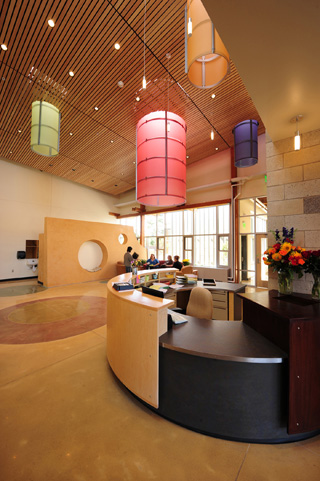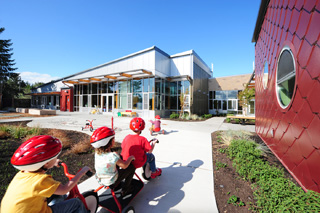|
Subscribe / Renew |
|
|
Contact Us |
|
| ► Subscribe to our Free Weekly Newsletter | |
| home | Welcome, sign in or click here to subscribe. | login |
Construction
| |
 |
July 22, 2010
Designing for early childhood education: What works?
McGranahan Architects

McGavock
|
We’re entering a period of growth for early childhood education in Washington. Not only did the state create the Department of Early Learning in 2006, the Legislature recently authorized a phased expansion of early learning enrollment.
School districts and other early learning providers will be paying great attention to the growing enrollment in the near future, if not already. We know that more children are coming and additional capacity will needed.
So it seems appropriate to ask: What makes a functional and engaging early learning center?
A comprehensive approach to early learning center design considers the educational priorities of three groups.
First are the young children, supporting their learning in appropriate ways at the very earliest age. Second are the young adults who, as new parents or before they become parents, need to be educated about child development and parents’ important role in it. Third are the practitioners and providers who need to be well educated and updated regularly on the latest research and best practices.
Early learning center designs should have an integrated focus on children, parents and practitioners.
Model for future centers
The new 13,000-square-foot early learning center at Tacoma Community College addresses all three aspects of early childhood education and offers many lessons that will be helpful in planning future centers.
The facility, which serves up to 116 children, includes classrooms for infants, toddlers and preschoolers. There is a resource room where parents can study and consult about guiding their child’s learning progress.
The new center provides a classroom for adults in the early childhood education/paraeducator programs at the college. Observation rooms adjacent to every classroom provide for practicum and field observation opportunities. The center was the first to be licensed by the Department of Early Learning.
Functional design
Beyond the host of compulsory regulatory and accreditation standards that were met, a number of functional strategies created shared benefits.

Classrooms are paired to share storage, food prep and toileting/changing facilities. Each pair of classrooms has a shared project area for messy activities like crafts and eating, with direct access to outdoors.
Observation rooms are located between classrooms and used by the teachers in the center to conference with parents. They are also used by students in the early childhood education/paraeducator programs without being a distraction in the classroom.
A parent resources/study area and the center’s program manager are connected to the welcoming main lobby of the building. All of the classrooms are located in secure zones accessed from the lobby.
Safety and security are paramount considerations, but they don’t have to be obvious or imposing. The facility is sited so parents can easily deliver their child to the center and go further on to campus for their classes. The building is configured in a way that it protects the children’s outdoor learning area from parking and campus pedestrian pathways.
Parent resources are located outside the secure classroom zone so they can come early to study while they wait for their children. There are only two interior security doors and they are easily monitored and controlled from the reception desk.
Nurturing environment
Important qualitative elements of the early learning center design create a nurturing environment for learning.
Indoor classroom spaces have expansive views and direct physical connections to the outdoors. Indoor and outdoor learning areas are treated as equally important. Natural light, natural materials, warm colors and playful design elements contribute to a rich, nurturing indoor setting.
Outdoor spaces stimulate the senses and challenge motor skills with a variety of materials appropriate for preschoolers (hard and soft, natural and crafted, smooth and textured) as well as a variety of slopes and grades to create many distinct areas where children can play independently or in small groups.
Circulation space between classrooms is also treated as learning, social space. For example, children can pick up smells from the kitchen, which is next to an eating/play area.
A sustainable approach
Sustainable design principles employed on this LEED gold project provide a healthy environment for children. Together with Tacoma Community College, the design team employed a holistic sustainable design approach to optimize the health and energy efficiency of the facility.
The building has natural ventilation, daylight to 94 percent of the occupied spaces and radiant floor heating to provide warmth where the children spend most of their day. Through the use of carbon dioxide and occupancy sensors, the ventilation systems ensure fresh air for good brain development and to maximize energy savings.
Enriching young lives
From the earliest times of our lives, the places associated with our formative experiences are a lasting part of our cherished memories. A thoughtfully designed facility leads to greater appreciation of our built and natural environment, an appreciation we hope children will carry with them into adulthood.
TCC’s early learning center was designed to enrich children’s lives long after they move on. The forms of the building are both sophisticated and playful, an acknowledgement of a place for children situated on a college campus.
|
See more online Take a brief video tour of the building at www.youtube.com/mcgranahanarchitects. More photos are posted at www.mcgranahan.com. Click on “Work,” then “Early Learning.” |
Arriving at the center, children are enthralled with the colorful translucent light tubes infused with daylight from skylights above. Playful light fixtures and ceiling fans are elements that add interest to their quiet times.
Children become explorers in the rich environment outdoors. The abundance of daylight and views to outdoors make a peaceful setting that is appreciated by children and adults alike.
The center is a place that serves all of the dimensions of early learning, in an integrated way for children as well as adults. As we look forward to an expansion of early learning services in Washington state, we hope that this center can be a model for other early learning centers to come.
Michael McGavock, a principal at McGranahan Architects, has focused his career on planning and design for education, from early learning to adulthood.
Other Stories:
- Let a developer build your school
- School pilot project could affect county stormwater rules
- Young children need room to stretch their minds
- Putting ‘community’ into community college campuses
- Why are school construction costs so low?
- Find out if your school is fit for a retrofit
- Give students a say on their school design
- Student-centered schools put learning first
- Industry takes a leading role in new skills center
- Site headaches can be a gift for students
- Money’s tight, so how about a living building?




